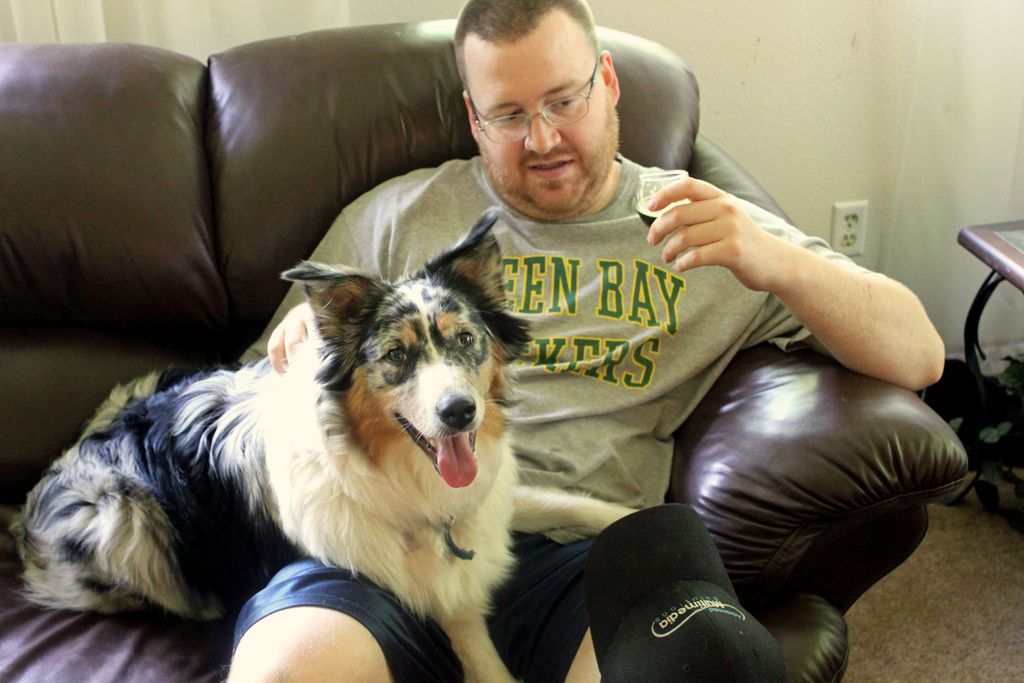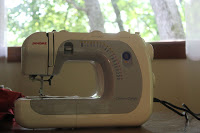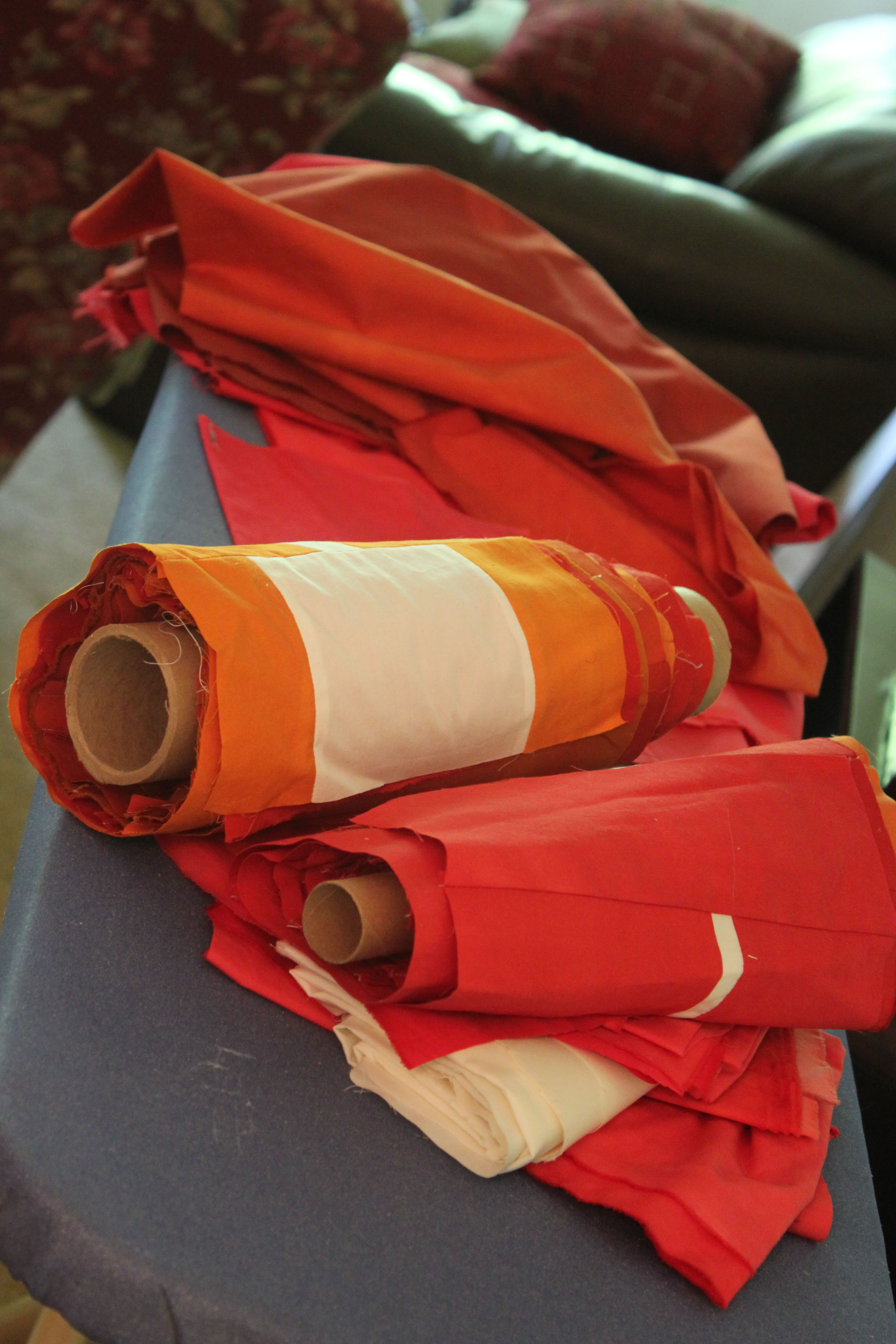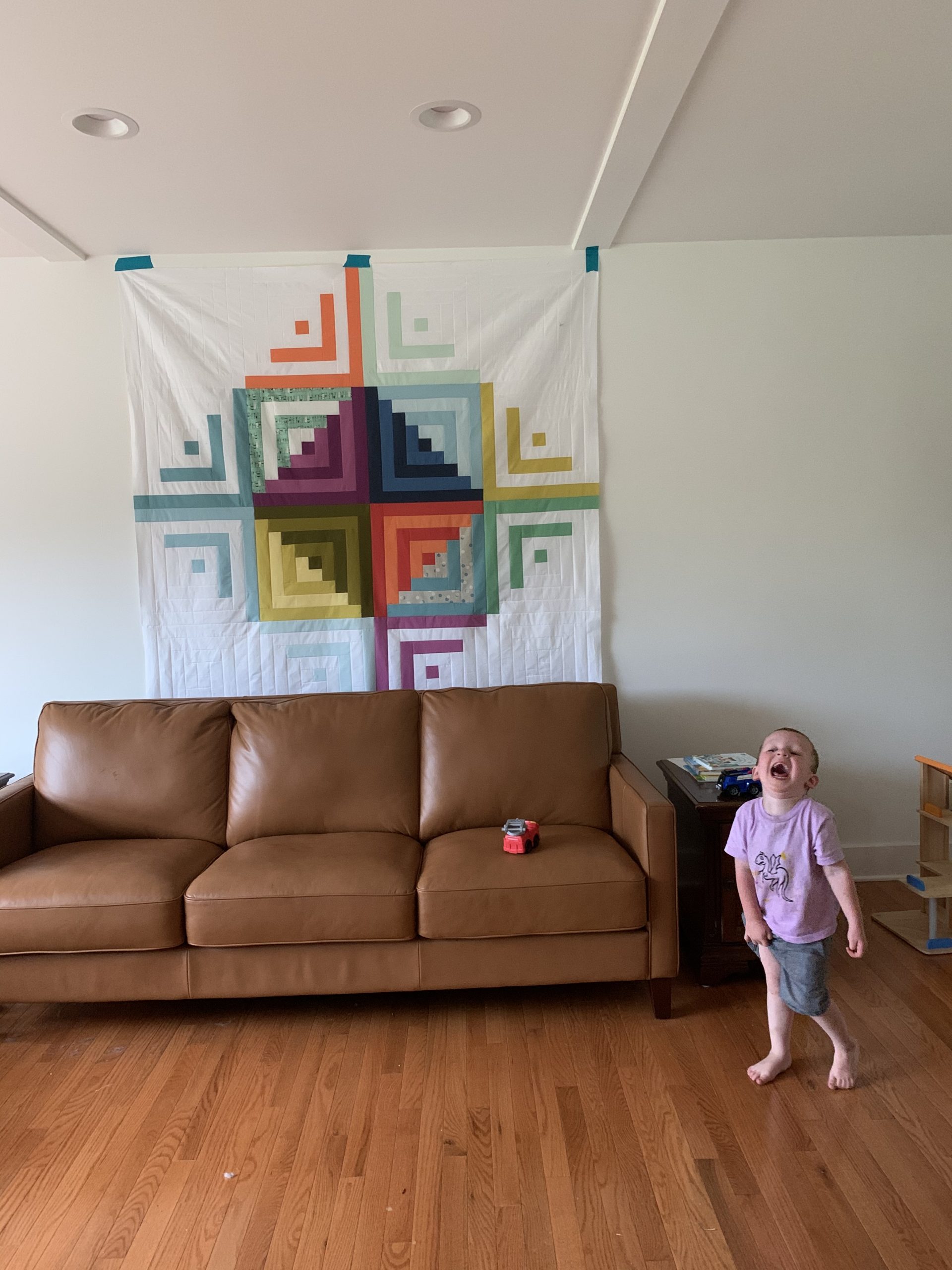I'm really pumped to be teaching at Quilt Con in February! SOFT CRITICISM - space…

More on modern
The quilt for Miss Stinky is done and at the quilters and I am safely ensconced in my childhood home for the next two weeks. Every good road trip starts with unwinding at Mom and Dad’s right? Plus, there are puppies and brothers here.
Also, a sewing machine. I had my old sewing machine tuned up before leaving town and have brought it to my parents’ house. This will be its new home.
My mom knows how to sew, but has not done much of it in recent years. This is partly due to busyness on her part, but also due to the fact that her supposedly rather nice sewing machine stopped working properly before she got her money’s worth out of it. I am hoping that using my old machine will revive her interest, it is also nice for me to have a machine to use while i am here.
I brought along my strips from the kelp quilt and am planning on finishing this top next week.
These strips are from the Mid Mod Bee. Speaking of mid-century modern, in the comments to the Modern Day Quilts interview, Rachel said,“I see the correlation to mid century modernism being very clear in modern quilts but other modern inspirations not being so well represented. Is this a personal choice? A fashion of the time?”
This is a question that I have as well. I love mid-century modern design and so it does tend to be what I am inspired by. I do sometimes see some more minimalist work and things that are more beatnik or mod. I think I start to lack the vocabulary for some of these though…if someone could recommend books or documentaries that tease out the threads in modernism, I’d be eternally grateful.
Kate wrote, “Crafts, to a large degree, have also changed from a handed-down tradition to an individual pursuit, in the vacuum of the craft room, with input from the internet.”
Does anyone know if this is true? I have been looking for, and failing to find, any rigorous studies of craft traditions and the extent to which they have been solitary, community based, or mediated. I have a mental picture of Laura Ingalls Wilder learning to sew from her mom, and the novice of today learning from YouTube, but anecdotes and easy-conjured mental images aren’t evidence of how craft works in people’s lives. Have there been histories that document this rigorously?
Quite a few people wrote about craft vs. art.
These words just seem like “master’s tools” for elevating what rich white men do with their minds and bodies (it’s art!) and devaluing what women and other minorities do with their minds and bodies (craft!). Am I wrong? When and why is this distinction useful?
Rachel said, “One of things I love about the ‘quilts’ I love is how well crafted they are. Sometimes I am kind of freaked out how badly some of the Modern Quilts are made. In photos, its hard to tell the level of craftsmanship so it doesn’t seem to carry any weight. I get great joy from the ‘making’ and have been repeatedly told that ‘craftsmanship’ is a ‘traditional’ value. Is this so? “
Well, I can’t really speak for how much “craftmanship” matters to other people, but I can answer for myself and speculate a bit. For myself: I piece improvisationally, so i don’t need to have PERFECT scant-1/4-inch seams on everything, because blocks are always going to get cut down and squared up as part of the process. I make good, stright seams that will hold up to wear. I press carefully and resew on the rare occassion that a seam is too skinny to be durable. I don’t have puckers or stretching or fudging.
From what I’ve seen in pictures and in person, most modern quilts are well constructed.
I think that craftmanship carries weight. However, I don’t think that modern quilts are celebrated for their technical achievements, but rather for their designs. So, I don’t really care if you tackled inset-seams unless I love the result of that tackling. It’s all about how it looks in the end, not how crazy you went trying to get there.
Also, what does not carry weight with me as far as craftsmanship goes is any notion of how things are “supposed to be done” or are “supposed to look” that doesn’t add to a quilt’s longevity or strength. I will show stitches when I want to. Combinations of colors, prints, and materials are of my own choosing. If I’m confident that the fabrics won’t shrink unevenly, I will combine voile, quilter’s cotton, linen, and more.
The traditional quilters that I know are far more interested in following rules.
One last question from Rachel: “I love print and tend to believe ‘more is more’ having been told that ‘solids is Modern’ do I have to put solids in my quilt to have it be Modern? isn’t it more about the design? ”
I think the use of negative space is one of the bellwethers of a modern quilt. This is usually accomplished with solids and near solids. However, I don’t think that using solids or lots of negative space is a requirement of modern quilts–you can have the disease without manifesting that symptom, as it were.
Dana noted, “It’s interesting to me that so few people notice that ‘Modern Quilts’ are so heavily influenced by African American quilting and African fiber traditions.”
I have seen that influence noted repeatedly and in the lecture I gave on modern quilting listed it alongside Japanese aesthetics as a major influence. Perhaps it should be brought up more often so that people can pull at that thread and rediscover those quilts. What other influences do people see?
This Post Has 10 Comments
Comments are closed.






I always have to preface my use of the term "Modern" with "Mid Century" when discussing quilts with my art historian daughter. She reminds me that Modern Art began with Romanticists, Impressionist, Fauvists and the like, who shook up the establishment with gobs of color and pattern, much like the the "Negative Space" in newer quilts can stir it up today.
I'm so glad you take the time to work through all the wording involved, and happy to have your quilts for inspiration!
I'm an art historian by training, so I find the discussions about "modern" quilting to be quite interesting. I think you hit the nail on the head with your comment about design vs technique being the hallmark of "modern" quilting. If you are interested in reading theoretical works from art historians about 20th century art and design, I can make a few recommendations.
I love reading these posts! They're very well written! As for the last statement, about modern having roots or similarities to African American/African traditions. I'd never thought of it until one of my local modern quilt guild members did a presentation about African American quilting and fiber arts. I am very inspired by the quilts of Gee's Bend. Particularly their way of storytelling and use of unpredictable materials (corduroy specifically). I am very inspired. 🙂 Thanks for keeping this discussion going. I like contemplating the roots of these things.
Oh and in case you were wondering your mention of learning quilting "in the vacuum of the craft room, with input from the internet" is spot on for me. I was taught basic sewing by machine (mostly by myself with a little encouragement from home ec class). But quilting was learned on my own. It's pretty empowering actually.
Awesome, awesome words! This is really great information to have in my hip pocket when people ask me to define modern quilting. (as if I could!)
Thank you so much for putting all this into words for us. I think so many modern quilters know this in our hearts and in our quilter's spirit, but it is hard to verbalize…especially for those of us without an art background!
Thank you.
Have you come across Thomas Knauer? He is doing an art history series on his sewing blog, all in the name of exploring the use of the term modern in quilting.
i love your posts that discuss definitions, labels, and what "modern" quilting means. you answer some questions and then dig deeper to ask an even better question of your readers.
inspiring.
This is by far the most interesting blog post I have read about modern quilting. Thank you for helping me understand more about the movement without all the animosity that seems to creep into so many posts about modern vs. traditional. I started quilting about 40 years ago, when quilting was not fashionable. I gave it up after a few years for other forms of fiber work – embroidery, weaving, needlepoint, counted cross stitch. I came back to quilting a couple of years ago to a whole new world. I love the traditional work, but I also love the clean lines and bold colors and designs of the modern quilts. It is so great to be quilting in a time where so much is possible. I found your blog from your interview at Modern Day Quilts. I will definitely be back.
So good to read all this work on wording! – comments included.
For the last couple of days I've been trying to come up with some words myself about what it means …
For me modern has to do with a function and shape, either the original function of a shape or the function that a shape has in the quilt/drawing/square that you're working on. It that sense it is also related to with back-to-basics or tradition, where craftsmanship and function are valued. It has to do with enjoying the course that a line can take. And it has also to do with the interesting point of creating some shape that is even better to look at in combination, repeated or contrasted with it's negative.
Wow – I really like formulating these kind of idea's – it helps me a lot when working on shapes and colors! I hope they make some sense to you all as well. Since I'm not born as a English writer (being from Holland) I might have mixed words and meaning…
I think I see the art vs. craft a little differently. Art is something beautiful that sits there forlorn, to be ogled but left alone.
Craft is art that is useful. Something beautiful that is meant to be used and integrated into life.
Art sits on the sidelines of life and throws splashes of beauty into it. Craft turns life into art.
To me the difference between art and craft has more to do with individual expression. Craft is doing something from a kit or exactly according to the directions (like replicating a quilt you saw in a magazine, even down to the exact fabric line used). It isn't unique. Art is when you start to deviate from the pattern to make something that expresses your own vision, rather than just copying.